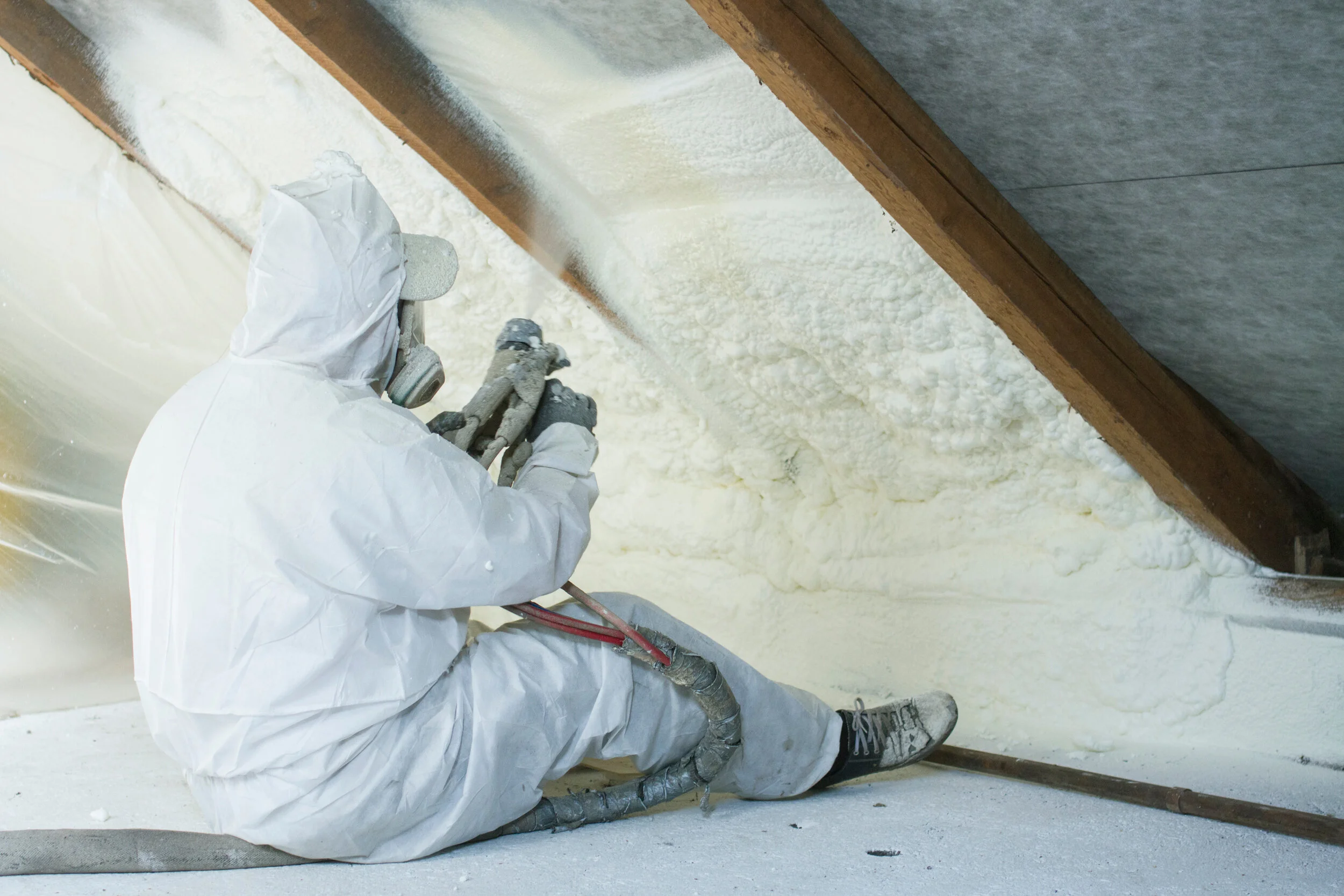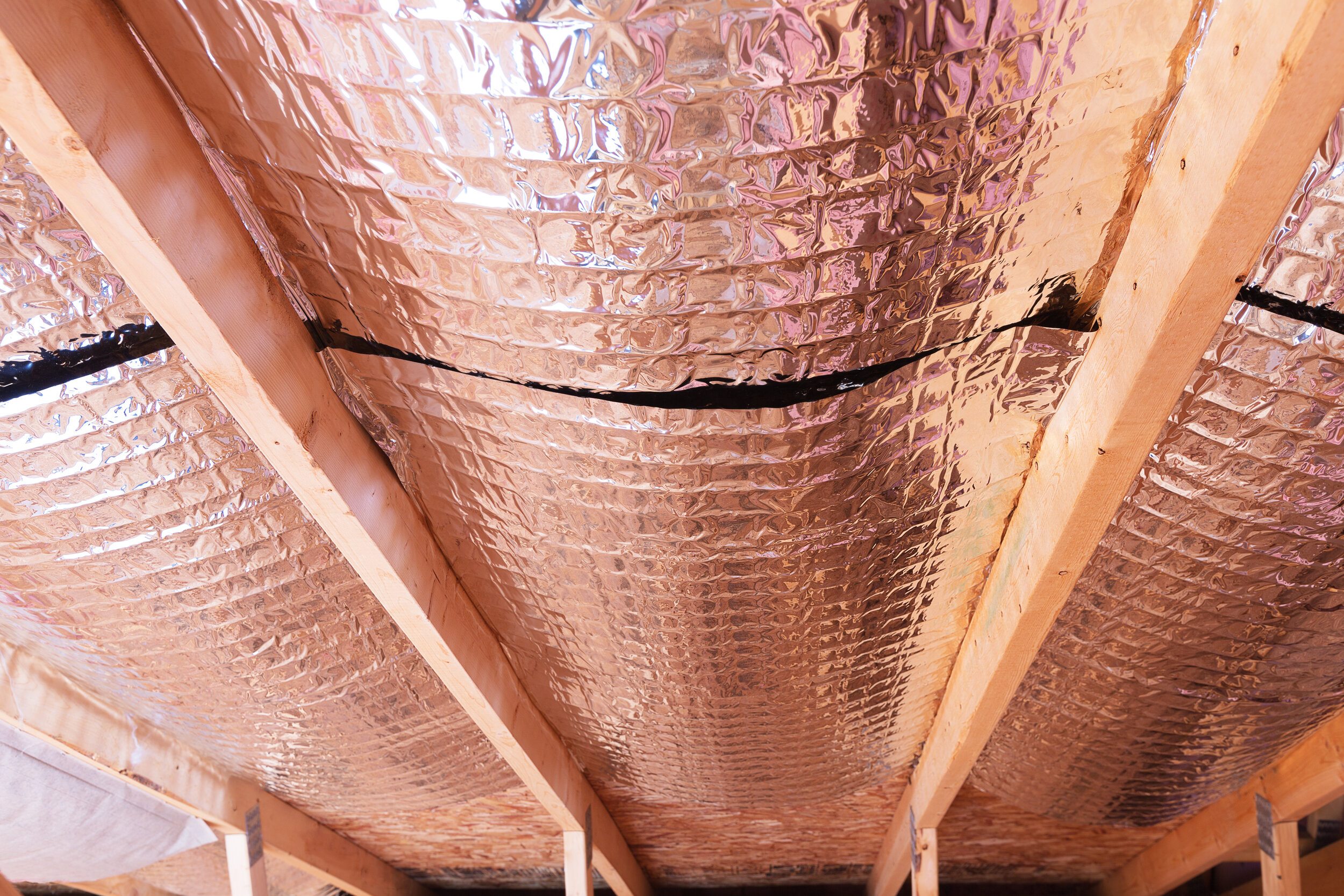The Cost Of Keeping Warm: Best Home Insulation Types
Spray Foam Attic Insulation
With the right insulation inside the walls, it’s easy to control the climate of a home without overspending on energy costs.
Because of record heat and cold in recent years, insulating the home has become an extremely important part of the home building and renovation process. And with so many different types of insulation on the market the cost, installation, and application vary.
Most large-scale insulation jobs—especially those that include large scale spray foam projects—are not recommend for DIYers. Since 50% of the energy used in the life of a building is for heating and cooling, the right insulation product and installation professional should be a priority.
Insulation R-Value
The R-Value is a rating system given to the insulation’s qualities, like thickness and density. Net, net - the higher the R-Value, the greater its effectiveness.
There are varying types of insulation, each providing a slightly different level of value or effectiveness. If the house is in a warm climate, it will require a lower R-Value. In a cold climate, a home will require a higher R-Value.
You can also bump up your R-Value by layering new insulation over the old stuff. Here’s a quick chart from Energy Star that spells it all out.
If you plan to add additional insulation on top of older insulation, your new R-Value of the combined layers is the combo of all of the individual layers. The more insulation in your home, the higher the R-Value and resistance to the flow of heat. But, the insulation’s ability to do its job depends on where and how the insulation is installed.
As an example, if the insulation is flattened between walls it will not provide the R-Value it might otherwise if it were installed in a more spacious area. Therefore, the R-Value of a wall or ceiling will likely differ from the R-Value given to the insulation from the factory.
Insulation comes in different forms and different materials. Some materials can be installed in various forms, others are limited.
Poorly Insulated Room
Insulation Cost and Types
Spray Foam Insulation
Cost: $4.00-$10.00 per square foot of wall space
Cost will vary based on the quality of the product used and experience level of your contractor
Dimensions: Spray foam insulation is largely a professionally installed product- consult with a spray foam insulation contractor before moving forward
Spray Foam Insulation R Value And Other Selling Points
Because of its ease of application, exceptional R Value, and other qualities, spray foam insulation is now one of the leading types of insulation used in a new build or renovated homes.
Spray foam air seals and insulates in one application step.
It’s a great option for your home because of its super adhesive qualities and instantaneous ability to expand and fill gaps and cracks. Keep in mind that large scale spray foam insulation projects should be done by a professional spray foam installation contractor.
The spray foam contractor will recommend the most appropriate type of spray foam to use in your home, and be most familiar with the expansion rate of each type of foam, avoiding any unintended damage.
The contractor will also have access to the necessary spray foam insulation equipment which can be challenging to rent. Spray foam can be used in enclosed, existing walls but is more commonly seen in open wall cavities, attics and new builds.
Open Cell Spray Foam
Open cell foam is made up of tiny connected bubbles.
The bubbles can absorb moisture so best not to use an open-cell spray foam in damp environments like basements and crawl spaces. It can be sprayed between rafters or studs, but its low R-Value won't provide much total insulation value in a confined space.
Open-cell foam is usually less expensive to install than closed-cell foam.
Closed Cell Spray Foam
Closed cell foam’s hard finish creates a great vapor barrier and touts a higher R-Value versus open-cell foam. Great Stuff is an example of a one component (one chemical) closed-cell foam.
Large scale closed-cell foam used by spray foam contractors for large builds, is referred to as a two-component polyurethane foam.
Fiberglass Insulation
Cost: $50-$60 Roll / $50-$100 Bag of Batts / $15-$30 Blown-In (Loose Fill Bag)
Dimensions: Rolls and Batt typically come in 15 inch and 23 inch width to fit 2x4 or 2x6 wall cavities, most rolls are 32 or 39.2 feet in length and batt 4 or 8 feet in length.
Blown-in fiberglass insulation comes in 30-pound bags
Fiberglass is the most popular insulation type, prevalent material used in a roll, batt or blown-in (loose fill) form and can easily be installed between studs, joists and beams. Fiberglass provides great sound insulation for walls.
Faced Fiberglass Insulation
Depending on the climate and with proper ventilation, faced fiberglass insulation will help reduce the opportunity for moisture to collect behind your walls.
Moisture control insulation uses a facing or paper barrier to reduce the moisture vapor that forms in-between walls and floors.
The paper contains a layer of asphalt adhesive which prevents water vapor from passing through it.
Most contractors will be sure to install the insulation with the paper facing toward the heated part of the home to prevent condensation build up caused by cold air.
Condensation can lead to waterlogged insulation and eventually rotting and mold.
Non-Faced Fiberglass Insulation
Non-faced fiberglass insulation can be used when moisture control isn’t a concern, like layering on to preexisting fiberglass insulation.
Non-faced is most commonly used for insulating an attic or in-between floors. Rolls can be cut to spec and great for large areas.
Batts are precut to 8-foot lengths making it easily installed in open/non-sheet rocked walls.
Blown-in works well in tough to reach spaces like closed wall cavities and attics, but won’t seal cracks or overly drafty areas well.
Mineral Wool Insulation
Cost: $45-$65 per bag of batt insulation varies by width
Dimensions: 15.5” X 47” and 24” X 48”
Also known as Rockwool, Slagwool, and Stone Wool – Mineral Wool is made from rock or basalt stone and spun into a fibrous material that looks a lot like blended wool.
Mineral wool was one of the first commercially produced insulation products, created all the way back in 1871. Although fiberglass is by far the most popular roll and batt product on the market, mineral wool is growing in popularity in the US.
You’ll see mineral wool much more frequently used residentially in Europe and Canada. Mineral wool is fire resistant, light yet dense, excellent for sound reduction, and its ease of installation between studs.
It also differs from fiberglass due to its slightly higher R value, denser and heavier material, increased water resistance, and higher price point.
Foam Board Insulation Cost
Cost: $10-$22 / Varies By Thickness
Dimensions: .5 inch, 1 inch and 2 inch Thick X 4 ft X 8 ft
Foam board insulation is a great option with a high R Value to thickness ratio for unfinished walls, including basement walls, floors and ceilings, and low slope attic roofs without ventilation. Use 1-Inch for floors and 2-Inch for walls.
Foam board excels in areas around the home that require a low-profile insulation option due to the foam board’s thin stature and high R value. Foam board is installed against concrete walls or using fasteners (cap nails or screws) to studs underneath drywall.
Foam Board is available in three types: Expanded Polystyrene (EPS), Extruded Polystyrene (XPS), Polyisocyanurate (Polyiso).
Expanded Polystyrene (EPS)
Expanded Polystyrene (EPS) has an R value of 4.0 per inch of thickness and tends to be the most inexpensive type of foam board available.
Most Expanded Polystyrene does not come faced so it’s the least versatile of the foam board options. Without facing Expanded Polystyrene also won’t create a water vapor barrier.
Extruded Polystyrene (XPS)
Extruded polystyrene XPS foam board, comes in different thicknesses and is usually referred to as green, blue and pink board depending on the manufacturer.
This is the most commonly used insulation foam board in residential construction with an R value of 5.0 per inch of thickness.
Polyisocyanurate (Polyiso)
Polyisocyanurate (Polyiso) is the most expensive of the foam boards but has the highest R value of 6, amongst it’s set.
Polyisocyanurate panels are faced (foil is the most common) since they start as a liquid foam and are molded to the face in order to form the board shape.
Due to the necessary foil facing, these panels are considered water vapor impermeable.
Vaper permeable versions are available and faced with fiber glass instead of foil.
Cellulose Insulation Cost
Cost: Blown-In $10-$15 per bag
Dimensions: 19 and 30-pound bags
Cellulose insulation is developed with a large percentage of recycled materials making it one of the most sustainable options on the market. It’s also one of the least expensive, and does a good job resisting fire, pests and mold.
Cellulose’s loose fill insulation can easily be blown-in to attic nooks, installed as rolls or batting between tight walls or professionally installed as a wet spray for new construction or a major remodel.
The downside to cellulose is that once it is saturated (think flood, leaky roof or burst pipe) with water it will start to decompose and settle causing opportunity for mold and the appearance of voids in your wall/attic spaces.
Blown-in loose cellulose insulation is also heavier than fiber glass, settling at a higher rate. This will eventually lead to voids in the walls and loss of heating or cooling.
If you encounter a hole in your wall or tear in a wall cavity, hard packed blown in cellulose insulation will spill out creating a dusty mess.
Radiant Barrier
Cost: $35-$50 per roll
Dimensions: 2 or 4 Feet Wide X 100 Feet Length
Usually installed in unfinished walls, ceilings, and floors a radiant barrier system is more commonly seen in warm climates as a way to reduce heat and energy costs associated with air conditioning.
The reflective material on the barrier bounces the heat away from the interior of the home.
In addition to the reflective materials, many radiant barriers include a filler like bubble wrap, giving the barrier some weight and preventing compression or collapse over time.
Insulation Prefabricated For Construction
Insulated Concrete Forms (ICF)
Used in new construction, an insulated concrete form is like a concrete sandwich.
The ICF is manufactured off site with two insulation foam boards on either side of the concrete layer.
The concrete can be poured in the cast on site or prefabricated in a factory and installed on site.
Build With A Bang: Integrated Concrete Foundation Ready For Install
Build With A Bang: Closeup Integrated Concrete Foundation
Structurally Insulated Panels (SIPs)
Another an all-in-one prefabricated option for new construction.
Each panel contains a middle of insulating foam board wedged between two structural facings – usually an engineered wood but could be metal or concrete.
Structurally Insulated Panels (SIPs) are more traditionally used for the building’s interior vs the Insulated Concrete Wall (ICF) which is more commonly used as an exterior wall.
*Most popular dimensions and weight
**Costs are as of publication date and on average









